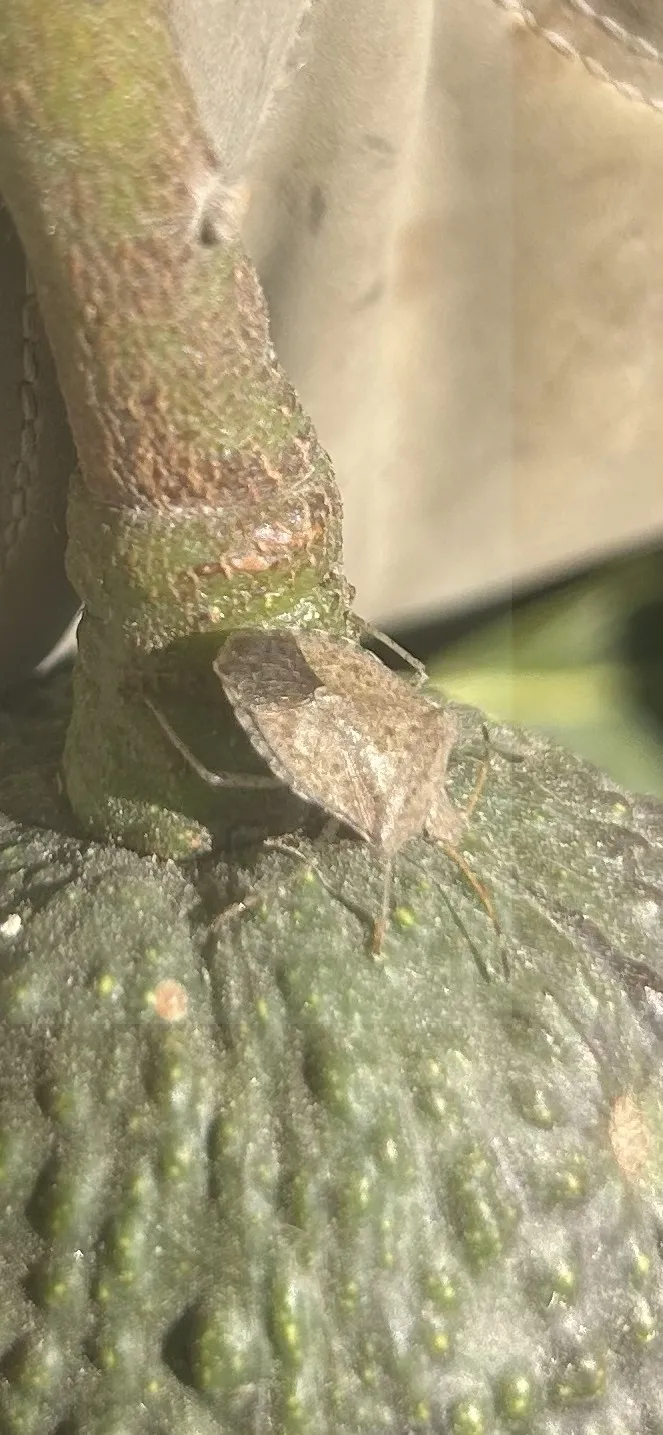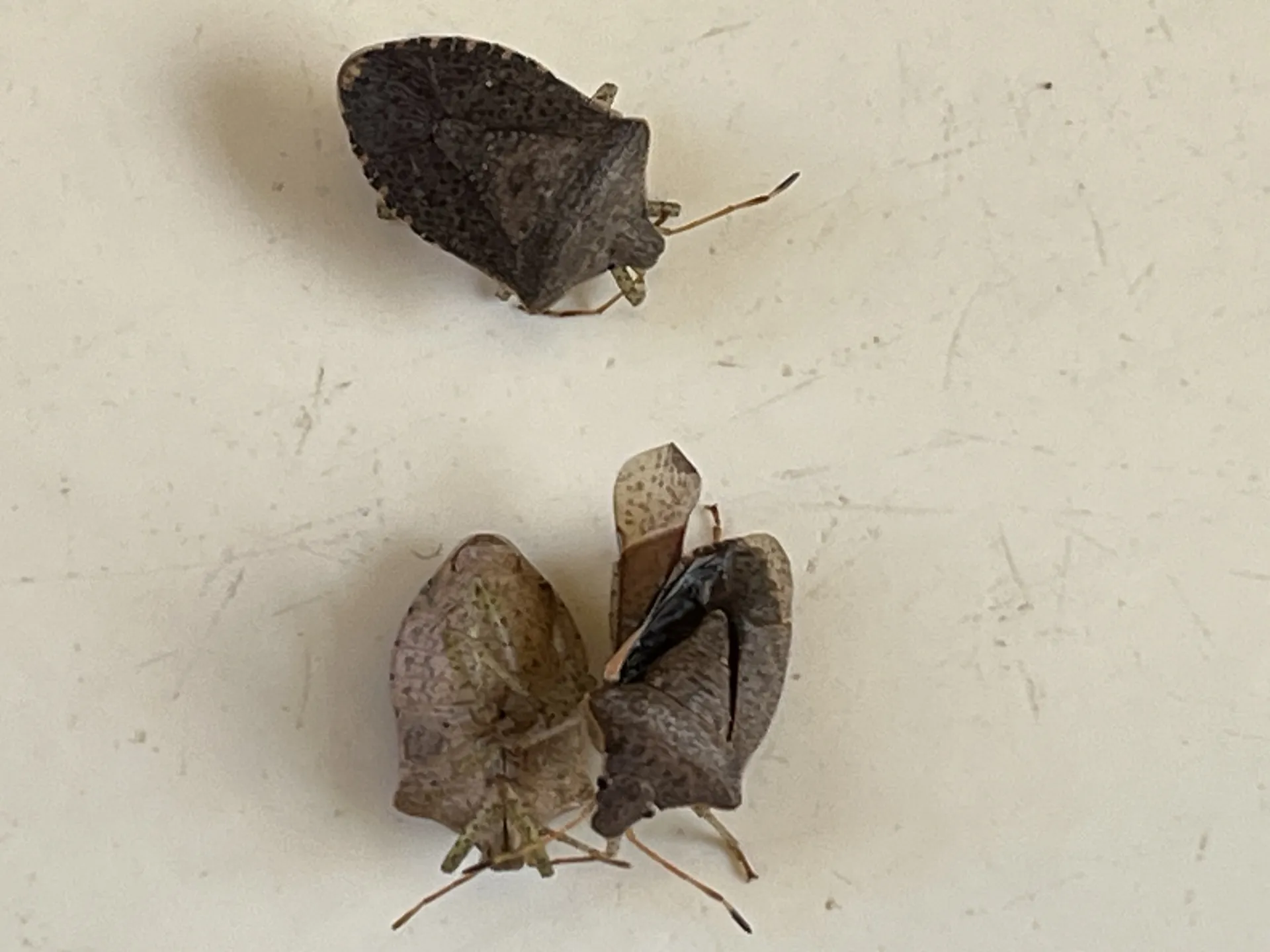In the last month there have been sightings of a stink bug on avocado fruit and stems in the Santa Paula/Fillmore area. The bug feeds on the stems of mature fruit, causing damage to the stem, creating wounds that leak white sugar exudate on the stem that drips on to the fruit. The weakened stem, can’t hold the fruit, and it drops. The stink bug can also feed directly on tender young fruit, as well.

Feeding damage on stem

Stink bug on fruit

Stink bug – Consperse Stink bug , Euschistus conspersus
We last had an outbreak in 2014 of Bagrada bug, another species of stink bug. The current outbreak was a different species that we first identified as Brown Marmorated Stink Bug (BMSB). We sent samples off to DR. Jhalendra Rijal, a UCCE nut advisor in the Central Valley who has done a lot of work on stink bugs. The identification came back as Euschistus conspersus. Consperse stink bug. The following is some of the dialogue he shared with us.
“Consperse can be found in any orchard and field crops system (pretty much), but the problem happens when their numbers get so high. I mean, collecting over 10 Consperse by hand indicates a pretty high population. So, something different is going on in the area. (The grower had collected 14 stink bugs to send to Jhalendra, so he’s saying there are a lot of bugs in that orchard).”
“We have observed a similar trend of increasing problems with stink bugs of all kinds, including BMSB, Consperse, green, etc. In the last 5-7 years, stink bug-led rejections in almonds have been high, and we are trying to understand which species is most important. I have been doing orchard surveys in the last 4-5 years with Almond Board funding support, and we collected all kinds of stink bugs from the orchards (almonds/peach). The northern San Joaquin Valley, where I am based, has a pretty good BMSB population and has been causing damage to almonds since our first detection in orchards in 2017. The population has spread to Sacramento Valley (Chico area) and southern San Joaquin Valley (Fresno, Visalia) areas too. We have seen some damage in that area too, but significant damage has been in the northern San Joaquin Valley region. We are now working in collaboration with the CDFA Biocontrol Program in testing the efficacy of Trissolcus japonicus (BMSB-specific parasitoid) in multiple almond orchards infested with BMSB. This project can be extended to other regions, too.”
“Regarding the control, all stink bugs are more or less similar in terms of their feeding as adults are likely to cause the most feeding damage. Stink bugs are difficult to kill with insecticides; timing is critical, plus what is outside of the orchard matters a lot . These stink bugs overwinter outside of the deciduous orchard and are highly polyphagous (feed on many plant species). So, the presence of multiple hosts in the area helps to build their population. For organic orchards, in addition to pyganic, a few additional products such as need and/or neem-pyganic combo products also work reasonably well against stink bugs in my experience. However, the residuals of these products are limited and require more frequent spraying. Recently, we updated. In 2020, I wrote a few BMSB-specific UCIPM guidelines that should help to understand this pest better, and learn more about this pest, its biology, monitoring techniques, etc. In addition, the updated guidelines have insecticides listed. Although those are for BMSB, most of those products should work fine for other stink bug species as well. Always check the label before applying any pesticides.
https://ipm.ucanr.edu/PMG/r3303211.html
Understanding the seasonal phenology of stink bug species is critically important for determining the best timing for control measures. Multiple companies sell the Consperse stink bug pheromone lures. Although they are less effective in orchard systems compared to field crops in my experience, they should still provide sufficient information on adult activity during the season if the pest pressure is high in the area. So, utilizing these commercially available traps and lures can help monitor Consperse stink bugs in high infestation pockets.”
“Also, we updated stink bug guidelines in peach and provided a table to identify commonly found stink bugs in the area. This might be a helpful tool as well, “ https://ipm.ucanr.edu/PMG/C602/m602stinkbugs.html
So, this is what we know of the consperse outbreak in the Santa Paula area. The grower and several of the surrounding avocado grower have sprayed with a pyrethroid which has knocked it out. The best recommendation at this point is to get the mature, ready to pick fruit off before damaged stems cause fruit drop. This will certainly be a concern if and when we get some hot winds this summer and fall. Only the low price of fruit now is halting a picking decision right now.

